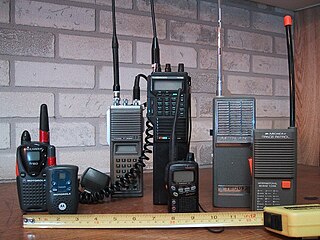Related Research Articles
A personal communications service (PCS) is set of communications capabilities that provide a combination of terminal mobility, personal mobility, and service profile management. This class of services comprises several types of wireless voice or wireless data communications systems, typically incorporating digital technology, providing services similar to advanced cellular mobile or paging services. In addition, PCS can also be used to provide other wireless communications services, including services that allow people to place and receive communications while away from their home or office, as well as wireless communications to homes, office buildings and other fixed locations. Described in more commercial terms, PCS is a generation of wireless cellular-phone technology, that combines a range of features and services surpassing those available in analogue- and first-generation (2G) digital-cellular phone systems, providing a user with an all-in-one wireless phone, paging, messaging, and data service.
Integrated Digital Enhanced Network (iDEN) is a mobile telecommunications technology, developed by Motorola, which provides its users the benefits of a trunked radio and a cellular telephone. It was called the first mobile social network by many technology industry analysts. iDEN places more users in a given spectral space, compared to analog cellular and two-way radio systems, by using speech compression and time-division multiple access (TDMA).

A walkie-talkie, more formally known as a handheld transceiver, HT, or handheld radio, is a hand-held, portable, two-way radio transceiver. Its development during the Second World War has been variously credited to Donald Hings, radio engineer Alfred J. Gross, Henryk Magnuski and engineering teams at Motorola. First used for infantry, similar designs were created for field artillery and tank units, and after the war, walkie-talkies spread to public safety and eventually commercial and jobsite work.

Base station is – according to the International Telecommunication Union's (ITU) Radio Regulations (RR) – a "land station in the land mobile service."
The 33-centimeter or 900 MHz band is a portion of the UHF radio spectrum internationally allocated to amateur radio on a secondary basis. It ranges from 902 to 928 MHz and is unique to ITU Region 2 (Americas). It is primarily used for very local communications as opposed to bands lower in frequency. However, very high antennas with high gain have shown 33 centimeters can provide good long-range communications almost equal to systems on lower frequencies such as the 70 centimeter band. The band is also used by industrial, scientific, and medical (ISM) equipment, as well as low-powered unlicensed devices. Amateur stations must accept harmful interference caused by ISM users but may receive protection from unlicensed devices.
GSM frequency bands or frequency ranges are the cellular frequencies designated by the ITU for the operation of GSM mobile phones and other mobile devices.

Sprint Corporation was an American telecommunications company. Before being acquired by T-Mobile US on April 1, 2020, it was the fourth-largest mobile network operator in the United States, serving 54.3 million customers as of June 30, 2019. The company also offered wireless voice, messaging, and broadband services through its various subsidiaries under the Boost Mobile and Open Mobile brands and wholesale access to its wireless networks to mobile virtual network operators.
ReadyLink was a "walkie-talkie" service, which used Session Initiation Protocol (SIP), offered by the Sprint Nextel Corporation, in an effort to compete with then-separate Nextel Communications. It was necessary to have a Sanyo or a Samsung ReadyLink capable phone and a matching service-plan in order to use this feature. ReadyLink sought to mimic the forerunning "MOTO Talk"/Nextel walkie-talkie service, except that ReadyLink was created to operate on the Sprint CDMA network. It was discontinued shortly after the Sprint PCS acquisition of Nextel Communications.

Cricket Wireless LLC is an American prepaid wireless service provider, wholly-owned by AT&T. It provides wireless services to thirteen million subscribers in the United States as of 2022. Cricket Wireless was founded in March 1999 by Leap Wireless International. AT&T acquired Leap Wireless International in March 2014, and later merged Cricket Wireless operations with Aio Wireless. Cricket Wireless competes primarily against T-Mobile's Metro by T-Mobile, EchoStar's Boost Mobile and Verizon's Visible in the prepaid wireless segment.

The Motorola i870 is a clam-style cellular telephone designed for use with iDEN Networks. It was released for SouthernLINC networks in mid-October 2005, and for Nextel on October 31, 2005 as a replacement for the i860. A variation of this phone, the i875, was released for Boost Mobile as a replacement for the i860 Tattoo.
MOTO Talk is a feature on some Motorola iDEN cellular phone handsets which allows users to make short-range 'push-to-talk' calls to other such handsets without being on the iDEN network. This feature goes by different names on iDEN service providers. In the US, Nextel called it 'DirectTalk' and included it as a free service on most new models of Motorola handsets. Boost Mobile disabled the function via handset software settings. SouthernLINC calls it LINCaround and ships handsets with the feature disabled. It can be enabled after paying an activation fee of $20. In Canada, TELUS calls it "Mike's Talk-Around."
Cellular frequencies in the United States are allocated by the US Federal Communications Commission. As cellular mobile telephone technology has evolved over time, periodically bands of frequencies are reassigned from other radio services. Companies wishing to provide cellular services in a geographic region compete for the right to license radio spectrum in spectrum auctions. Different cellular companies in the same region may use different levels of cellular technology and different parts of the radio spectrum. In addition to radio frequencies used to connect handsets with cellular base stations, other parts of the radio spectrum are used to interconnect base stations and the wired telephone network. Some frequency bands may be vulnerable to interference by existing services in adjacent frequency bands, such as UHF television broadcasting.
The Samsung SPH-A640 is a tri-mode dual band cellular telephone developed for PCS carriers like Sprint Nextel in the United States and Virgin Mobile in Canada. It was released in mid to late 2006 in most areas in the United States and other countries such as Canada.
XPress Telecom was a wireless telecommunication operator in Jordan. It has been shut down because of financial problems. It holds a digital trunking radio system license from the country's telecommunication regulatory body, the TRC; the technology used is Motorola's proprietary iDEN technology operated on the SMR-800 frequency band.

Nextel Communications, Inc. was an American wireless service operator that merged with and ceased to exist as a subsidiary of Sprint Corporation, which would later be bought by T-Mobile US and folded into that company. Nextel in Brazil, and formerly in Argentina, Chile, Peru, the Philippines, and Mexico, is part of NII Holdings, a stand-alone, publicly traded company not owned by Sprint Corporation.

Long-Term Evolution (LTE) is a standard for wireless broadband communication designed to provide high-speed data transmission for mobile devices and data terminals. Commonly marketed as 4G LTE, it is a key technology in modern cellular networks, enabling faster internet speeds and improved connectivity.

Public Mobile Inc. is a Canadian self-serve mobile brand which is owned by Telus. Launched on March 18, 2010, Public Mobile was one of several new Canadian cellphone providers that started in 2009–10 after a federal government initiative to encourage competition in the wireless sector.
Clearnet was a division of Telus Mobility launched in April 2011 to sell landline and mobile phone bundles in Western Canada. It was a revival of the Clearnet Communications brand name, which originally belonged to an independent cellular provider that was merged into Telus Mobility in 2000. Telus relaunched Clearnet as a discount provider with a "limited market trial" in Kelowna, British Columbia and Red Deer, Alberta.

The Motorola i920/i930 is Motorola's first wave of iDEN Protocol-based smartphones.

DISH Wireless L.L.C., doing business as Boost Mobile, is an American telecommunications company and wholly owned subsidiary of EchoStar Corporation. Boost Mobile is the fourth largest wireless carrier in the United States. Together with its sister brands Gen Mobile and Ting Mobile, it serves 7 million subscribers as of September 30, 2024.
References
- 1 2 Carson, Phil (January 29, 2007). "Sprint bids for own iDEN users". RCR Wireless News. p. 5.
- ↑ Meyer, Dan (August 13, 2007). "Operating in a shadow - Sprint Nextel, T-Mobile USA find varied success against big 2". RCR Wireless News. p. 4.
- ↑ "Sprint Nextel suffers more iDEN losses". Mobile Radio Technology. June 2007. p. 12. ProQuest 197261218.
- ↑ Parker, Tammy (2013-06-05). "Sprint turns iDEN shutdown into massive recycling project". Fierce Network. Retrieved 2024-12-12.
- ↑ Meyer, Dan (2012-05-29). "Sprint Nextel to begin iDEN turn down mid-2013; scores $1B credit facility". RCR Wireless News. Retrieved 2024-12-12.
- ↑ Johnson, Allison (2022-07-01). "Sprint's network has been officially retired". The Verge. Retrieved 2024-12-12.
- ↑ German, Kent (November 16, 2006). "Motorola ic502". CNET. Archived from the original on December 29, 2006.
- ↑ "Motorola Deluxe ic902 now available from Sprint". Telecomworldwire. June 15, 2007. ProQuest 191081412.